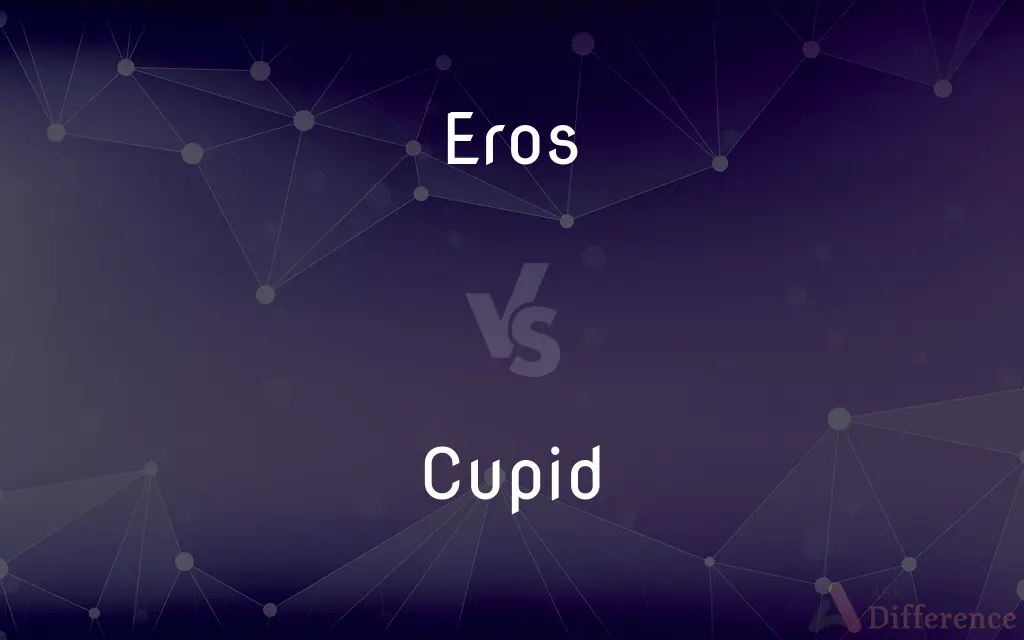Eros vs. Cupid — What's the Difference?
By Maham Liaqat & Urooj Arif — Updated on March 30, 2024
Eros is a primordial god in Greek mythology symbolizing love, while Cupid is his Roman counterpart, often depicted as a playful, winged child.

Difference Between Eros and Cupid
Table of Contents
ADVERTISEMENT
Key Differences
Eros is often depicted in ancient art as a handsome and powerful young man, embodying idealized youthful beauty and the irresistible power of attraction. This portrayal contrasts with Cupid’s more innocent and whimsical image, highlighting the Romans' adaptation of the god to symbolize the playful aspects of love, often focusing on the lighter, romantic side rather than the primal forces of desire.
The myths surrounding Eros are diverse and complex, reflecting his status as a primordial god. He is sometimes shown playing a role in the creation of the world and the birth of gods and mortals. Cupid's myths, however, are more uniform and often involve humorous tales of love and desire, focusing on his relationships with gods and mortals alike, including his romantic stories with Psyche, which emphasize the trials and tribulations of love.
Eros' influence extends beyond the realm of mythology into philosophical discussions, particularly in works like Plato’s "Symposium," where he is discussed in terms of metaphysical desire and the pursuit of beauty and goodness. Cupid, while also a figure in literature and art, is more commonly associated with Valentine's Day and the commercialized aspects of love, demonstrating the cultural differences in how love and desire are conceptualized between the Greek and Roman societies.
The worship of Eros in ancient Greece involved rites and rituals celebrating the natural forces of life and creation, recognizing his role in fertility and the continuation of society. Cupid’s veneration in Rome did not have the same depth, focusing more on his role as a symbol of romantic love, often celebrated in festivals like Lupercalia, which later influenced modern Valentine’s Day traditions.
Comparison Chart
Origin
Greek mythology
Roman mythology
ADVERTISEMENT
Depiction
Handsome young man
Winged child or infant
Parentage
Varied (Chaos or Aphrodite)
Venus and Mars
Myths
Complex, creation-focused
More uniform, romantic
Cultural Influence
Philosophical discussions
Valentine's Day, romantic icon
Worship and Rites
Fertility and creation
Symbol of romantic festivities
Compare with Definitions
Eros
Associated with deep metaphysical concepts of desire.
Plato’s Symposium discusses Eros in the context of seeking truth and beauty.
Cupid
Typically shown as a playful, winged child.
Art and literature frequently depict Cupid as a mischievous infant or toddler.
Eros
His origins vary, sometimes considered a primordial god or the son of Aphrodite.
In some stories, Eros is born from Chaos, symbolizing the chaotic nature of love.
Cupid
Symbolizes the lighter, often commercialized aspects of love.
Cupid is a familiar figure in modern Valentine’s Day celebrations and decorations.
Eros
Represents the fundamental force of love and desire.
Eros was considered a driving force behind the creation of the world in some myths.
Cupid
Central to various myths, especially his relationship with Psyche.
The story of Cupid and Psyche explores the trials of love and the soul’s journey.
Eros
Often portrayed as a beautiful, eternally young man.
Ancient art shows Eros as a symbol of youthful beauty and desire.
Cupid
Son of Venus (Aphrodite in Greek mythology) and Mars (Ares in Greek).
His lineage reflects the combination of love's beauty and war's vigor.
Eros
Played a crucial role in rituals celebrating life, fertility, and creation.
Eros was worshipped in ancient Greece as a god vital to the continuation of society.
Cupid
Known as Amor in Latin, embodies romantic love and desire.
Cupid is often depicted striking targets with his arrows to invoke love.
Eros
Greek Mythology The god of love, son of Aphrodite.
Cupid
In classical mythology, Cupid (Latin Cupīdō [kʊˈpiːdoː], meaning "passionate desire") is the god of desire, erotic love, attraction and affection. He is often portrayed as the son of the love goddess Venus and the god of war Mars.
Eros
The sum of all instincts for self-preservation.
Cupid
Roman Mythology The god of love; the son of Venus.
Eros
A winged figure of a child representing love and/or its power.
Cupid
Cupid A representation of Cupid as a naked cherubic boy usually having wings and holding a bow and arrow, used as a symbol of love.
Eros
A type of love that seeks fulfillment without violation or something else.
Cupid
A putto carrying a bow and arrow, representing Cupid or love.
Eros
(psychiatry) libido
Cupid
Any of various lycaenid butterflies of the genera Chilades, Cupido and Everes.
Eros
(psychiatry) collective instincts for self-preservation; life drive.
Cupid
The god of love, son of Venus; usually represented as a naked, winged boy with bow and arrow.
Pretty dimpled boys, like smiling cupids.
Eros
Love; the god of love; - by earlier writers represented as one of the first and creative gods, by later writers as the son of Aphrodite, equivalent to the Latin god Cupid.
Cupid
(Roman mythology) god of love; counterpart of Greek Eros
Eros
(Greek mythology) god of love; son of Aphrodite; identified with Roman Cupid
Common Curiosities
Who is older, Eros or Cupid?
Eros is the older figure, originating from Greek mythology, while Cupid is his Roman adaptation.
What is the significance of Eros and Cupid’s arrows?
Their arrows symbolize the power to invoke love and desire in gods and mortals alike, with Cupid's arrows specifically being used in tales to cause both love and aversion, reflecting the unpredictable nature of love.
Do Eros and Cupid have the same parents?
No, their parentage differs. Eros has varied origins, sometimes considered a primordial god or the son of Aphrodite. Cupid is consistently described as the son of Venus and Mars in Roman mythology.
How are Eros and Cupid represented in art and culture today?
Eros' image as youngs can be found in classical art and literature, representing deep, passionate love, while Cupid’s childlike figure is prevalent in popular culture, especially in association with romantic love and Valentine’s Day.
Can Eros and Cupid affect gods and mortals alike?
Yes, in myths, both Eros and Cupid have the power to affect both gods and mortals, demonstrating the universal and formidable nature of love.
Are there any festivals associated with Eros and Cupid?
In ancient Greece, festivals celebrating Eros emphasized fertility and creation. In Rome, Cupid was associated with Lupercalia, a precursor to modern Valentine’s Day celebrations.
How do philosophers view Eros?
Philosophers, especially in ancient Greece, viewed Eros as a powerful force driving towards beauty, truth, and the good, far beyond mere physical desire.
Why is Cupid often depicted as a child?
The Romans depicted Cupid as a child to symbolize the innocence and playfulness of love, contrasting with the more powerful and chaotic nature of Eros in Greek mythology.
What differentiates Eros and Cupid in mythological stories?
Eros, in Greek mythology, is one of the primordial gods, representing the fundamental force of love and the creative urge. On the other hand, Cupid, known in Latin as Amor, is the Roman version of Eros.
What lesson can be learned from the myth of Cupid and Psyche?
The myth teaches about the trials of love, the importance of trust and overcoming obstacles, and the journey of the soul towards eternal love.
Share Your Discovery

Previous Comparison
Vector vs. Vehicle
Next Comparison
Era vs. DecadeAuthor Spotlight
Written by
Maham LiaqatCo-written by
Urooj ArifUrooj is a skilled content writer at Ask Difference, known for her exceptional ability to simplify complex topics into engaging and informative content. With a passion for research and a flair for clear, concise writing, she consistently delivers articles that resonate with our diverse audience.
















































